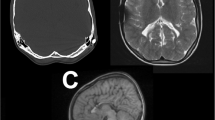Abstract
Two patients with intracranial arachnoid cysts, one with myelomeningocele–hydrocephalus and the other with a subdural fluid collection, were given a cerebrospinal (CSF) extracranial shunt. All four patients developed features of CSF overdrainage following shunting and were treated by cranial vault expanding procedures. Before undergoing decompressive craniotomy, the patients were treated by a variety of procedures, including changing of obstructed ventricular catheters (n=4), insertion or upgrading of programmable valves (n=3), and foramen magnum decompression (n=1). Clinical manifestations of these four patients were attributed to craniocerebral disproportion caused by chronic and progressive skull changes due to dampening of the CSF pulse pressure, which is necessary for maintaining normal cranial growth. On the basis of our previous experience with expanding craniotomies in cases of minimal forms of craniosynostosis, we treated these patients with bilateral parietal craniotomies, with satisfactory results. In conclusion, biparietal decompressive craniotomy constitutes a useful and safe procedure for relieving the clinical manifestations of some CSF overdrainage syndromes, especially in cases with slit-ventricle syndrome and craniocerebral disproportion that prove to be refractory to simpler management procedures.





Similar content being viewed by others
References
Albright AL, Tyler-Kabara E (2001) Slit-ventricle syndrome secondary to shunt-induced suture ossification. Neurosurgery 48:764–770
Allan R, Chaseling R (2004) Subtemporal decompression for slit-ventricle syndrome: successful outcome after dramatic change in intracranial pressure wave morphology. J Neurosurg Pediatr 101:214–217
Anderson H (1966) Craniosynostosis as a complication after operation for hydrocephalus. Acta Paediatr Scand 55:192–196
Benzel EC, Reeves JD, Kesterson L, Hadden TA (1992) Slit ventricle syndrome in children: clinical presentation and treatment. Acta Neurochir (Wien) 117:7–14
Buxton N, Punt J (1999) Subtemporal decompression: the treatment of non-compliant ventricle syndrome. Neurosurgery 44:513–518
Chumas PD, Armstrong DC, Drake JM, Kulkarni AV, Hoffman HJ, Humphreys RP, Rutka JT, Hendrick EB (1993) Tonsillar herniation: the role more than the exception after lumboperitoneal shunting in the pediatric population. J Neurosurg 78:568–573
Cohen SR, Dauser RC, Newman MH, Muraszko K (1993) Surgical techniques of cranial vault expansion for increases in intracranial pressure in older children. J Craniofac Surg 4:167–176
Di Rocco C (1994) Is the slit ventricle always a slit ventricle syndrome? Childs Nerv Syst 10:49–58
Di Rocco C, Tamburrini G (2003) Shunt dependency in shunted arachnoid cyst: a reason to avoid shunting (letter). Pediatr Neurosurg 38:164
Di Rocco C, Velardi F (2003) Acquired Chiari type I malformation managed by supratentorial cranial enlargement. Childs Nerv Syst 19:800–807
Eide K, Helseth E, Tønnesen BD, Lundar T (2001) Changes in intracranial pressure after calvarial expansion in children with slit ventricle syndrome. Pediatr Neurosurg 35:195–204
Epstein FJ, Fleisher AS, Hochwald GM, Ransohoff J (1974) Subtemporal craniectomy for recurrent shunt obstruction secondary to small ventricles. J Neurosurg 41:29–31
Epstein FJ, Lapras C, Wisoff JH (1988) “Slit-ventricle syndrome”: etiology and treatment. Pediatr Neurosci 14:5–10
Fischer EG, Welch K, Shillito JJR (1977) Syringomyelia following lumboureteral shunting for communicating hydrocephalus. J Neurosurg 47:96–100
Gough J, Walker DG, Theile R, Tomlinson FH (2005) The role of cranial expansion for craniocephalic disproportion. Pediatr Neurosurg 41:61–69
Hassounah MI, Rahm BE (1994) Hindbrain herniation: an unusual occurrence after shunting an intracranial arachnoid cyst (case report). J Neurosurg 81:126–129
Hoffman HJ, Tucker WS (1976) Cephalocranial disproportion. A complication of the treatment of hydrocephalus in children. Childs Brain 2:167–176
Holness RO, Hoffman HJ, Hendrick EB (1979) Subtemporal decompression for the slit-ventricle syndrome after shunting in hydrocephalic children. Childs Brain 5:137–144
Khorasani L, Sikorski CW, Frimm DM (2004) Lumbar CSF shunting preferentially drains the cerebral subarachnoid over the ventricular spaces: implications for the treatment of slit ventricle syndrome. Pediatr Neurosurg 40:270–276
Lazareff JA, Kelly J, Saito M (1997) Herniation of the cerebellar tonsils following supratentorial shunt placement. Childs Nerv Syst 14:394–397
Maixner VJ, Besser M, Johnston IH (1992) Pseudotumor syndrome in treated arachnoid cysts. Childs Nerv Syst 8:207–210
Martínez-Lage JF, Alamo L, Poza M (1999) Raised intracranial pressure in minimal forms of craniosynostosis. Childs Nerv Syst 15:11–16
Martínez-Lage JF, Ruíz-Maciá D, Valentí JA, Poza M (1999) Development of a middle fossa arachnoid cyst: a theory on its pathogenesis. Childs Nerv Syst 15:94–97
Martínez-Lage JF, Pérez-Espejo MA, Almagro MJ, Ros de San Pedro J, López F, Piqueras C, Tortosa J (2005) Síndromes de hiperdrenaje de las válvulas en hidrocefalia infantil. Neurocirugia (Astur) 16:124–133
Payner TD, Prenger E, Berger TS, Crone KR (1994) Acquired Chiari malformations: incidence, diagnosis and management. Neurosurgery 34:429–434
Rekate HL (1993) Classification of slit-ventricle syndromes using intracranial pressure monitoring. Pediatr Neurosurg 19:15–20
Salah S, Sunder-Plassman M, Jellinger K (1977) Late death in cases of treated internal hydrocephalus caused by encephalo-cranial disproportion. Mod Probl Paediatr 18:149–151
Shuster BA, Norbash AM, Schendel SA (1995) Corrections of scaphocephaly secondary to ventricular shunting operations. Plast Reconstr Surg 96:1012–1119
Vassilyadi M, Farmer JP, Montes JL (1995) Negative pressure hydrocephalus. J Neurosurg 83:486–490
Walsh JL (1979) Subtemporal decompression and elevation of shunt valve pressure in the management of transient shunt obstruction from slit ventricles. Childs Brain 5:556–557
Welch K, Shillito J, Strand R, Fischer EG, Winston KR (1981) Chiari I “malformation”—an acquired syndrome? J Neurosurg 55:604–609
Acknowledgement
We wish to thank Mr. Saturnino Espín, of our Hospital’s Unit of Photography, for his inestimable help with the art work.
Author information
Authors and Affiliations
Corresponding author
Rights and permissions
About this article
Cite this article
Martínez-Lage, J.F., Ruiz-Espejo Vilar, A., Pérez-Espejo, M.A. et al. Shunt-related craniocerebral disproportion: treatment with cranial vault expanding procedures. Neurosurg Rev 29, 229–235 (2006). https://doi.org/10.1007/s10143-006-0022-z
Received:
Accepted:
Published:
Issue Date:
DOI: https://doi.org/10.1007/s10143-006-0022-z




